Do you have a Griswold cast iron skillet and want to know its age or how to identify it using Logos? In this article, you can learn to date and recognize your Griswold cast iron using markings and logos.
I will focus on the dates and logos for collectible cast iron skillets manufactured by Selden & Griswold and Griswold Manufacturing Company between 1873 and 1957.
Table Of Contents
- Selden & Griswold cast iron
- Erie cast iron
- Griswold cast iron skillet logos.
- Victor cast iron
- Iron Mountain
- Good Health cast iron.
- Best Made skillets
- Puritan cast iron
- Merit cast iron
Learn To Date And Identify Your Griswold Cast Iron.
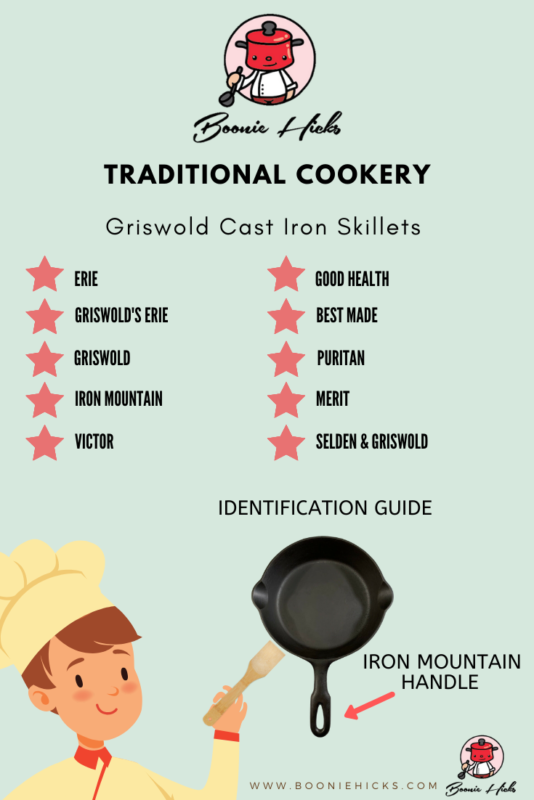
Griswold Manufacturing Background
Origins | Griswold Manufacturing Company dates back to 1868 when it was a small operation making door hinges. |
Selden & Griswold Manufacturing Company (1873-1884) | The Selden and Griswold family business became the Selden & Griswold Manufacturing Company. |
Griswold Manufacturing Company (1885-1957) | The company grew to one of America’s largest and most respected cast-iron manufacturers of the 20th century. |
Reasons For Collectibility | Cast Iron collectors highly regard Griswold cast iron skillets, and they are sought-after because of their smooth cooking surfaces and lighter weight. |
Desired And Rare Skillets | Look out for the first series of Erie and Erie Spider skillets. These two skillets stand out as the most sought-after by collectors. Also, rare sizes such as the Griswold #13 and #20 do not come up for sale often, but these large skillets can sell for a handsome sum when they do. |
| Most Valuable Griswold Skillets | The Erie Spider and Griswold 13 can cost a pretty penny. But the most valuable Griswold skillet is your family skillet. Family skillets vary in size and condition and have various logos. However, they are the most treasured and loved family heirlooms. |
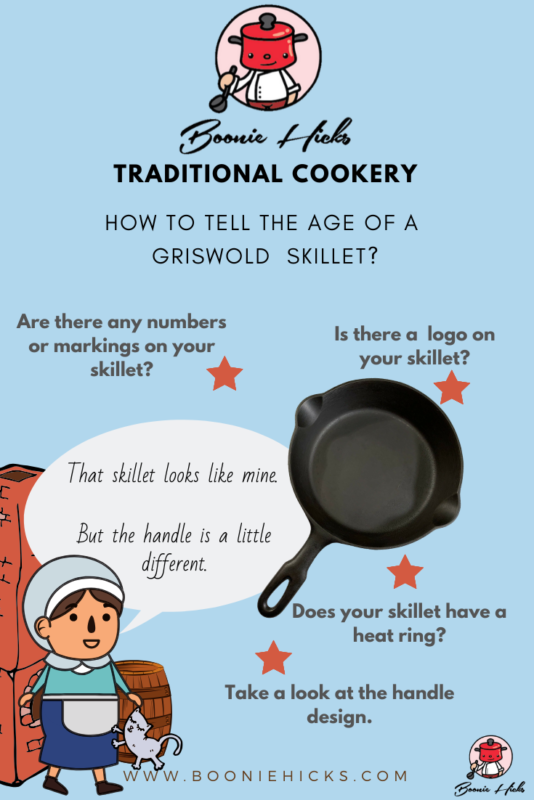
Selden & Griswold Cast Iron 1873-1884
Matthew Griswold and two brothers from the Selden teamed up and started to make door hinges in 1868. Their factory was known as the Butt Factory, named after the door hinge (butt hinge) manufactured in the casting works.
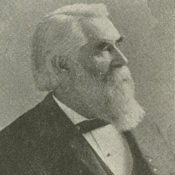
Selden & Griswold started to manufacture hollowware in 1873. But most of the cookware with this logo was probably made in the 1880s. Even though Mathew Griswold bought out the company in 1884, he still used the Selden Griswold logos.
After all, Griswold would have taken a lot of time and money to register new patent designs. And to make new molds. Check out our other article to learn about the history of Griswold Manufacturing. Wikipedia also has some information on Griswold. Although I hope my article is a little more detailed.
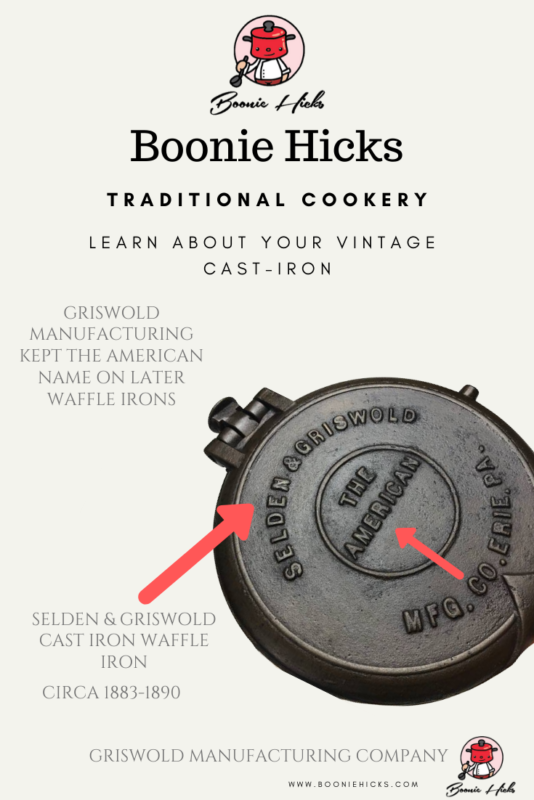
How Old Is My Griswold Cast Iron Skillet? Logo Approximate Dates
“Erie” Logo | Made around 1880-1907 |
Griswold’s Erie (Griswold diamond logo) | Circa 1884-1910 |
Style changed Griswold’s Erie | Circa 1905-1906 |
Griswold introduced a new logo design known as the circle cross logo. Slant Logo | With heat ring circa 1906-1916 |
Slant Logo With E.P.U. | Circa 1906-1929 |
Slant Logo Without Erie | No Erie under logo circa 1909-1920 |
Griswold With Large Block Logo | Without italic lettering, 1920-1930 |
Large Block Logo (Without Heat Ring) | Circa 1930-1939 |
Griswold Large Slant Logo (Without Heat Ring) | 1939-1944 |
Small Block Logo | Notable reduction in logo size. Circa 1939-1957 |
Erie Cast Iron (Approximation Date 1880-1907)
Erie cast iron is one of the most sought-after vintage cast iron brands you can collect. Griswold used this logo between 1880 and 1907.
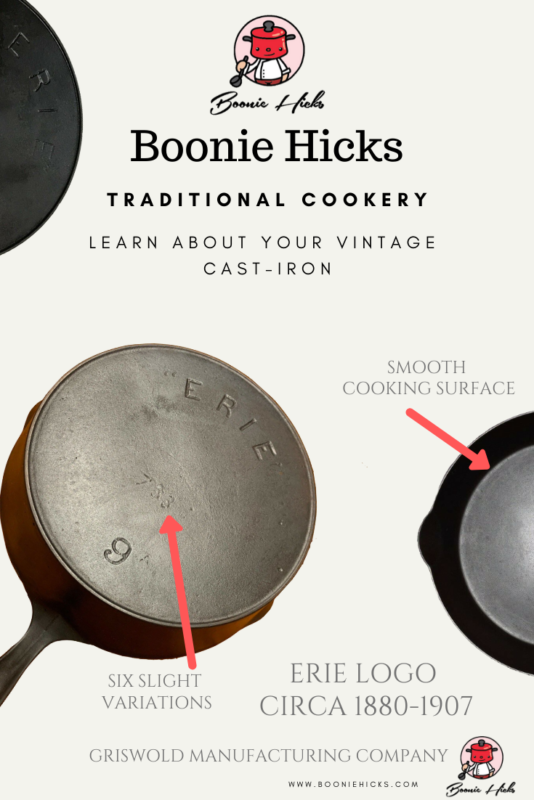
Erie cast iron skillets are very thin and light. Because of this, they are more prone to warping. So when you buy an Erie online, ask the seller if the skillet rocks or spins. That said, I would not look past an Erie skillet just because it has a little movement.
Erie skillets are also known to be super smooth and are often priced similarly to other vintage pans.
Some foundries used Erie skillets as a template to make their molds. So you may find Sidney Hollow Ware and Wapak Skillets with an Erie ghost mark.
If you have an Erie skillet, you can further break the Erie logo into six different variations. The Wagner and Griswold Society has an article on the markings and variations of the Erie skillets.
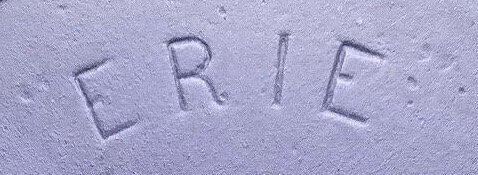
Diamond Logo
Look at the back of your cast iron Griddle, and if you see a diamond logo. Then it is your lucky day. The Griswold Diamond logo is an early logo that is more scarce than other logos.
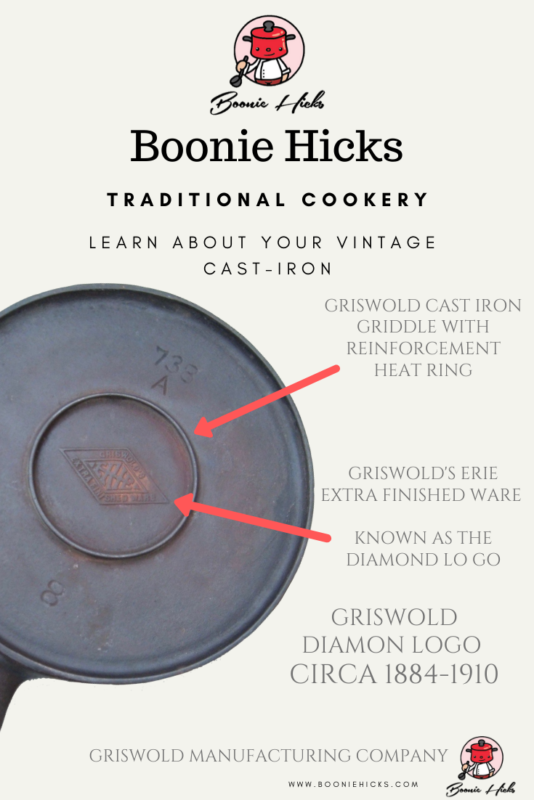
Griswold manufactured griddles with this logo circa 1884-1910. The logo is in the center of the backside. Unfortunately, the center is an area often damaged by sulfur pitting.
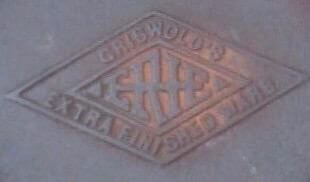
Griswold’s Erie Trademark
Griswold used this logo somewhere between 1905-1909. There are conflicting dates, so I used a conservative timeline. Since Griswold used the Griswold’s Erie logo for a shorter time, these skillets can be harder to find.
The Griswold’s Erie logo is the first Griswold logo. It transitions from previously used Erie logos to Griswold logos. However, Griswold’s Erie logo shares similarities with Erie skillets.
Sizes
Look for Griswold’s Erie skillets between sizes 6-9 and 11 to 12.
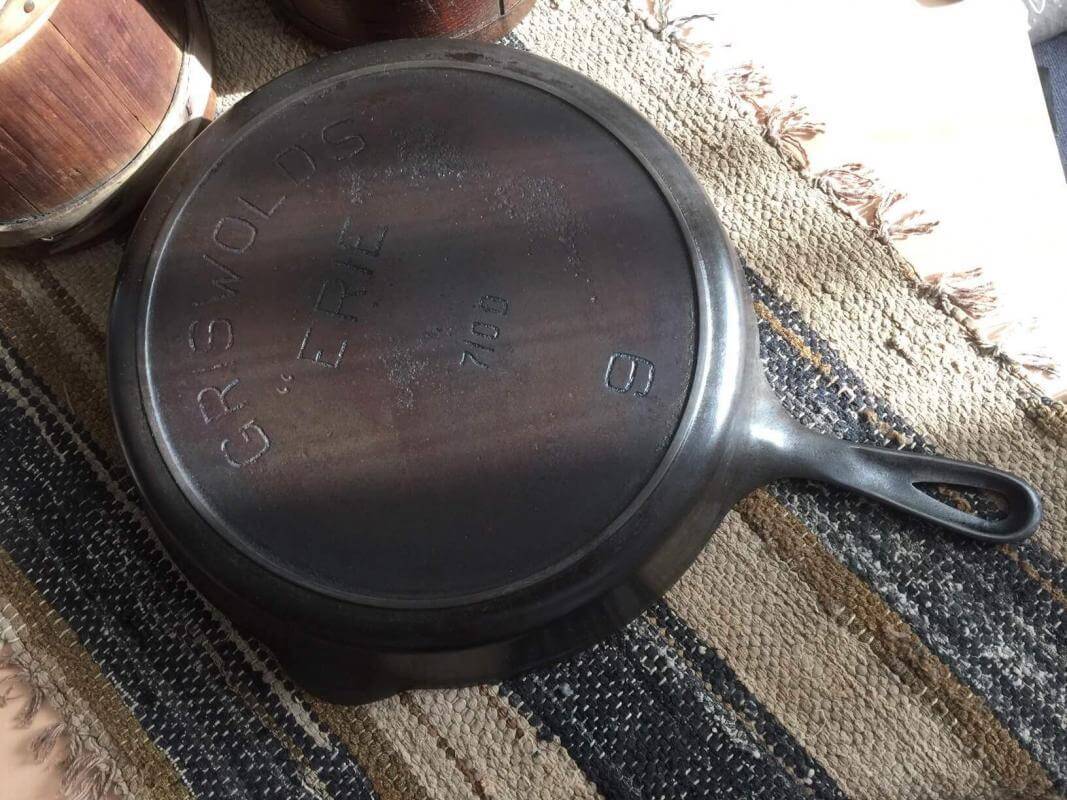
Griswold Slant Logo With Heat Ring And No E.P.U.
The slant logo is the first of the famous Griswold skillet logos. The Griswold Manufacturing company used the Slant trademark from 1906 to 1916. these dates give a slightly broad timeline, and cast iron enthusiasts would narrow this timeline down.
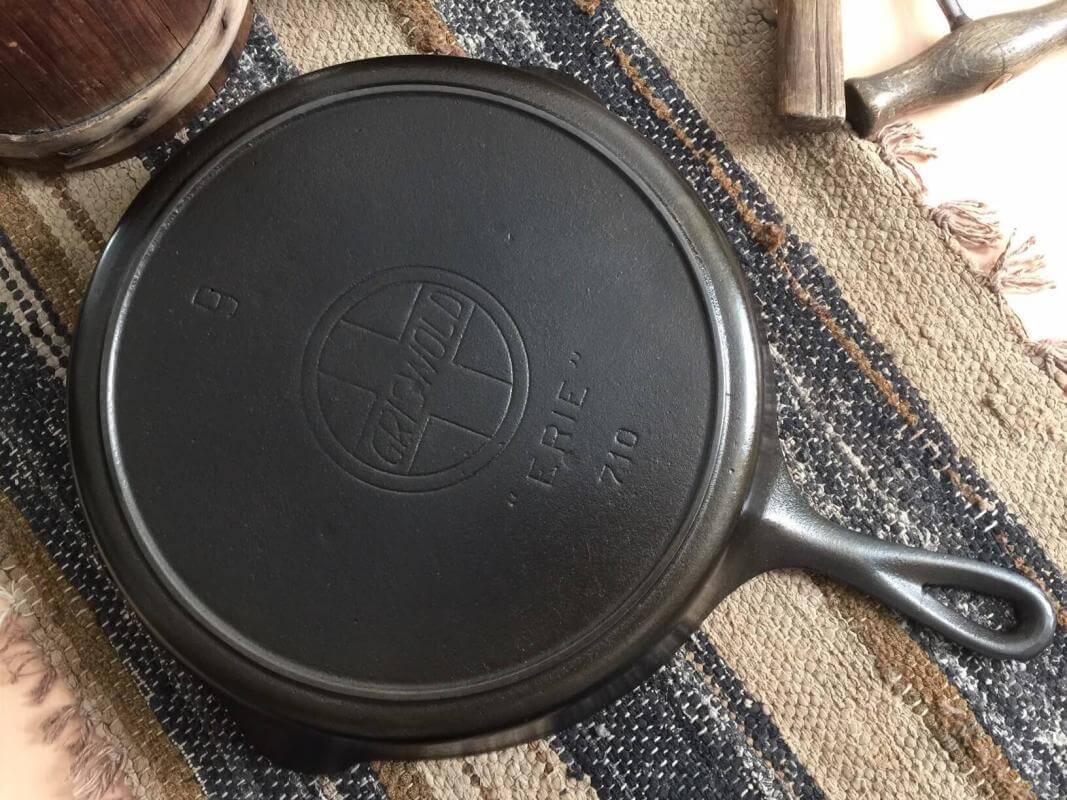
The Griswold slant logo is easy to recognize with the word Griswold in italics. Also, the Slant logo has characteristics that differ from Erie and Griswold’s Erie skillets.
Changes Griswold Made On Their Slant Logo Skillets.
- The size number on the base of the skillet moved from the 6 o’clock to 12 o’clock position.
- The word Erie is below the Griswold logo. The early Erie skillets have the marking at 12 o’clock.
- The pattern number moved from the center of the skillet to 6 o’clock on the skillet to make room for the Griswold circle cross logo.
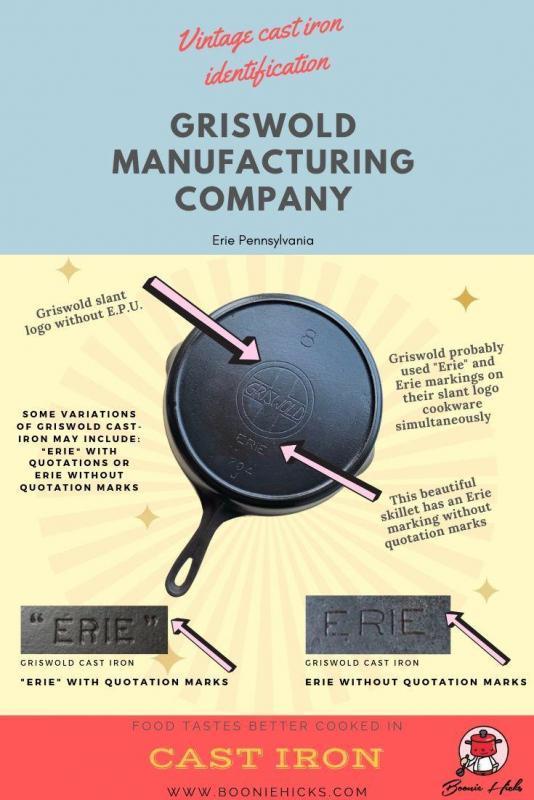
Griswold Slant Logo Sizes
Slant logo sizes range from 1-14. The largest skillet with the Griswold Slant logo is #14. A Griswold #13 slant logo can cost thousands of dollars to the serious collector. The skillet has to be in excellent condition to achieve this price.
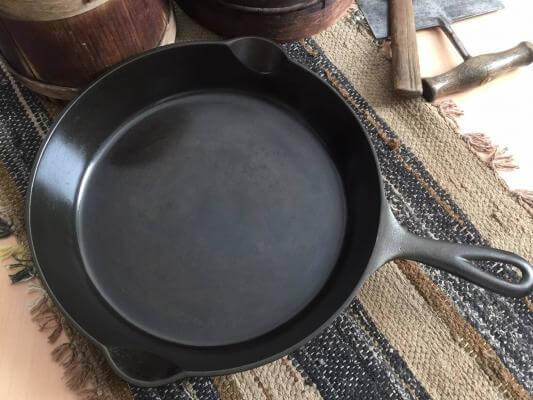
Griswold Slant Logo With E.P.U. And Heat Ring
The Griswold slant trademark changed to add the words cast iron skillet in an arc at 12 o’clock on the skillet. The E.P.U. refers to the wording Erie PA., U.S.A., on the skillet.
The slant logo, however, remained the same. Again, I cannot pinpoint the exact date of manufacture of the Griswold slant logo with E.P.U. If you have a Griswold slant logo with E.P.U., the manufacture date is around 1909-1929.
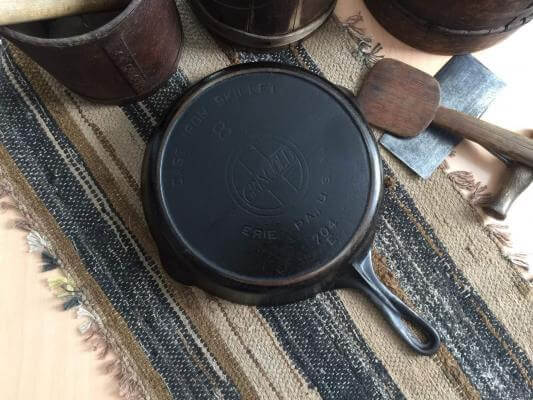
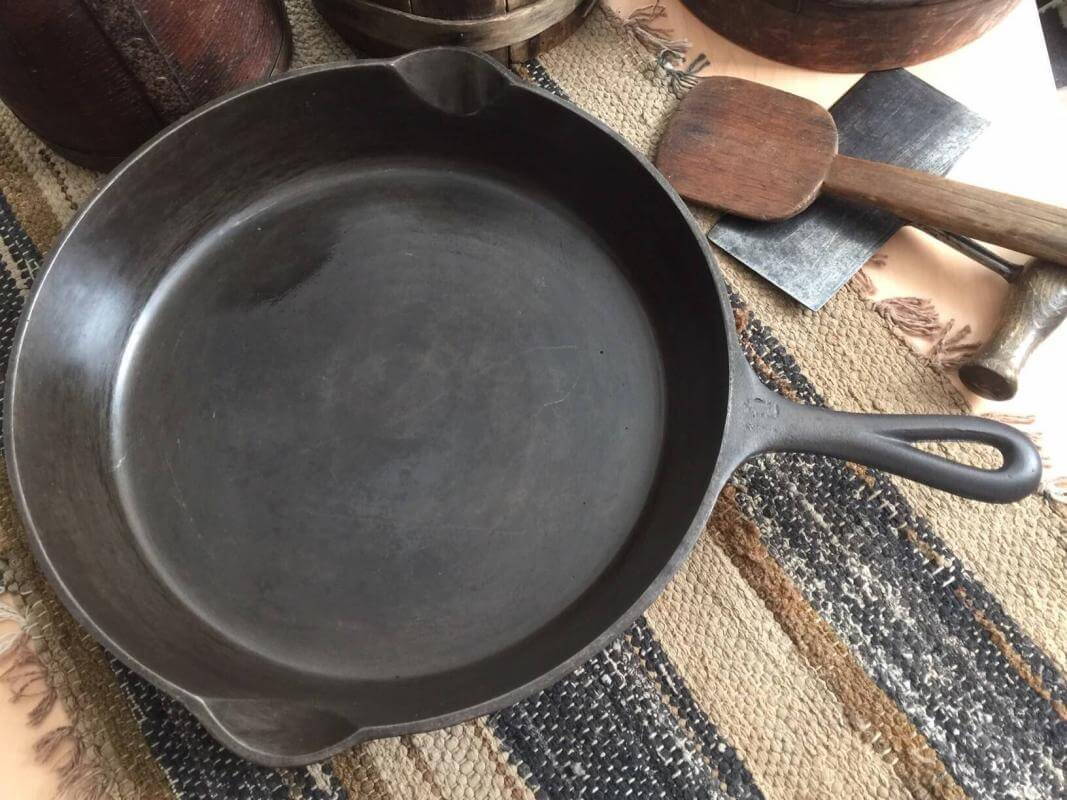
Slant Logo Without Erie Marking
I have only seen this trademark used on a few Griswold cast iron skillets. It seems to be quite rare. The logo is the same as the Slant logo without the E.P.U. wording on the skillet. This logo also omits the marking Erie.
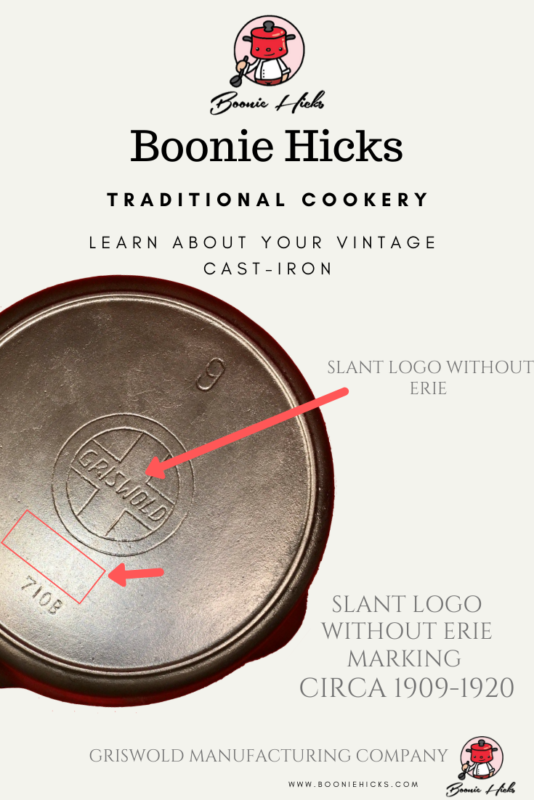
Griswold cast iron skillets without Erie marking have a manufacture date of around 1909 to 1920.
Sizes available: I have only seen the large slant logo without Erie on size #9 skillets. I do not know of other skillet sizes that came with this logo.
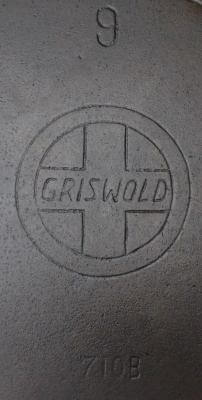
Large Block Logo (With Heat Ring)
The large block logo is one of the more popular markings or trademarks. It is known as the Griswold block logo. The block logo is very similar to the Slant logo. However, the word Griswold is no longer in italics. Griswold is in straight-block lettering.
Skillets with the block logo are circa 1920 and 1930. Griswold also manufactured a wide range of sizes ranging from 0 to 14. However, Griswold Manufacturing also made a number 20.
The Griswold #20 is a massive skillet and can cost a pretty penny online. It is called the Griswold Hotel Skillet.
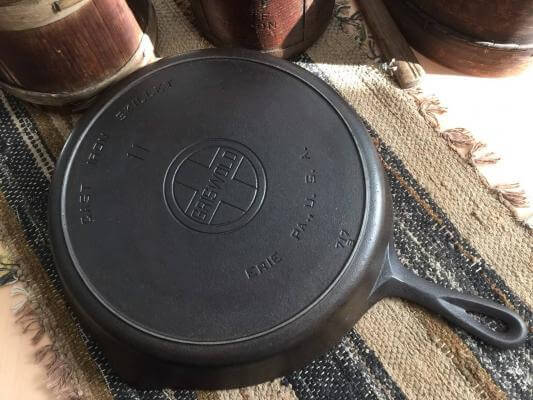
Large Block Logo Without Heat Ring (Smooth Bottom)
Griswold also put the large block logo on cast iron skillets with a smooth bottom rather than the familiar heat ring. However, the sizes were more limited. Look out for sizes between 2 and 10 to collect a complete set.
Smooth bottom skillets are not as sought-after to collect as skillets with heat rings. So you can expect to pay less for a Griswold without a heat ring.
Why the change? Cookware with heat rings was for use on wood or coal ranges. However, with the introduction of electric cookers, cast iron cookware with heat rings slowly gave way to cast iron skillets without heat rings.
Do you want an excellent old skillet without the price tag of highly collectible pieces? Then, using a skillet with the Griswold Large Block trademark could be a great option.
Griswold made skillets with the large block logo and a flat bottom between 1930 and 1939.
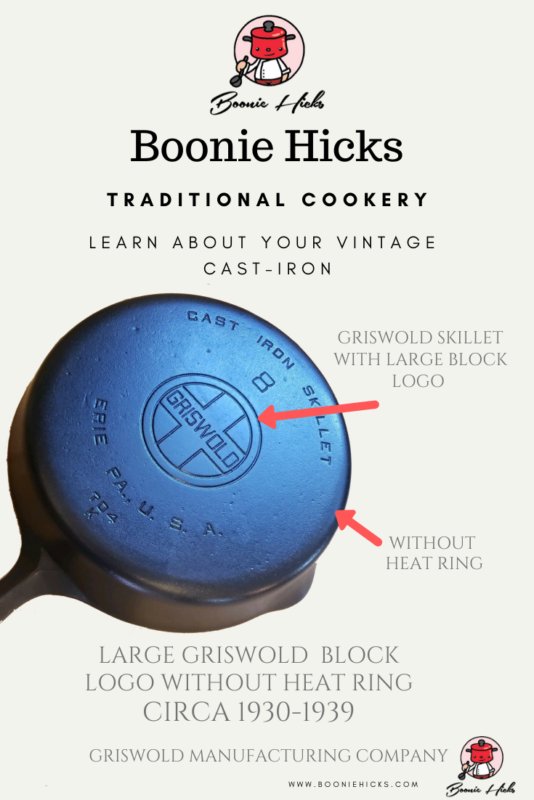
Griswold Slant Logo Without Heat Ring
Griswold also used the Slant logo on smooth bottom pans.
However, slant logos on skillets without a heat ring are not as common as skillets with a heat ring. These pieces sell at a similar price to a smooth bottom Griswold with a block logo. Griswold made these skillets between 1939-1944.
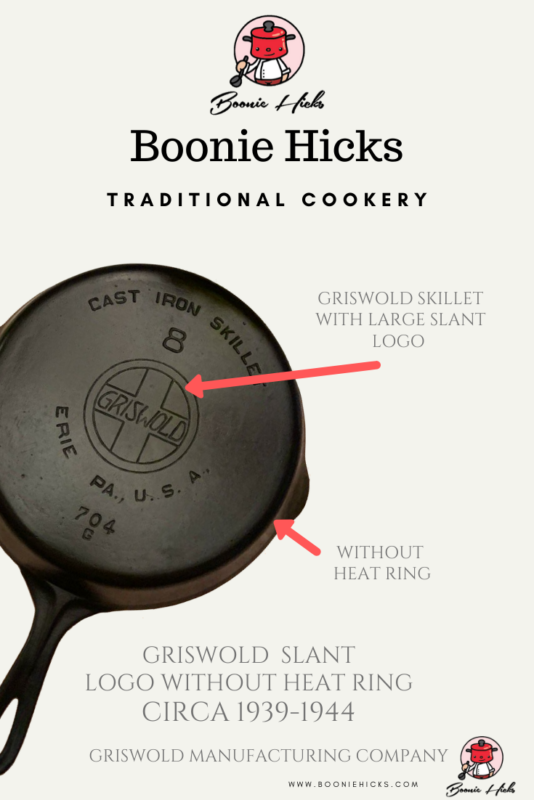
Small Block Logo.
The Griswold Small Block marking is not as collectible to cast iron enthusiasts, but they are still fantastic skillets. Griswold drastically reduced the size of the logo, and skillets came without a heat ring. Skillets lost much of their character. But there are some beautiful skillets around with the small block logo.
Watch out for sellers pricing these skillets at high prices because you can expect to pick up a skillet with the Griswold small block logo at a lower price than more collectible skillets.
That’s not to say the small block skillets are any good. But the small block logo is not as collectible so that you may pick a good skillet at bargain prices.
The Small Block logo is from circa 1939 and 1957.
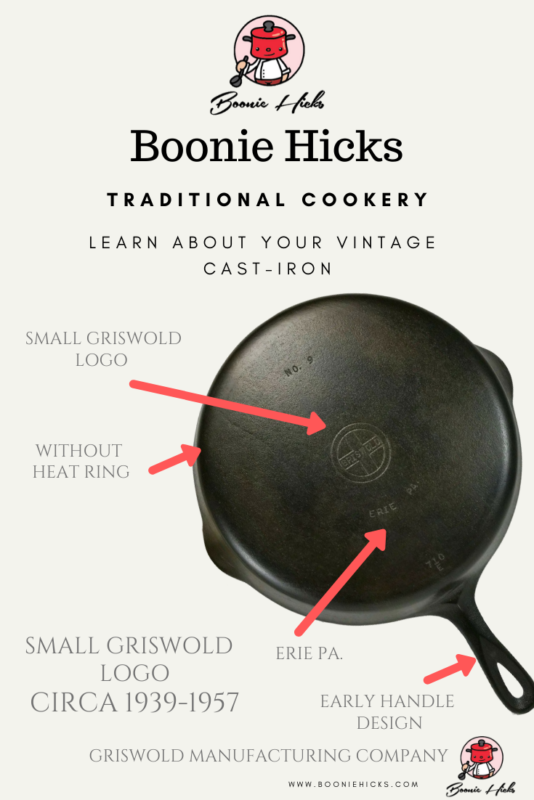
Do you have a skillet with a small block logo? Then check out this article. You will learn three different handle types to estimate the age of your skillet better.
Griswold Manufacturing’s Big Brands Were Erie And Griswold. But They Also Made Cast Iron Cookware Under Different Brands.
The Griswold Manufacturing Company, like other foundries, made a lower-grade range of cast iron cookware and was more budget-friendly.
Griswold Manufacturing Budget-Friendly Line.
Victor | Circa 1890s to the 1930s. |
Iron Mountain | Circa 1930s-1940s. |
Victor Cast Iron is A Budget-Friendly Brand Manufactured By Griswold.
Victor was a budget-friendly line of cast iron. Griswold made Victor Skillets between the 1890s and 1930s. The logo has also changed over the 50 years, with Victor at the 12 o’clock position like Erie skillets. However, the Victor logo on the cast iron skillets became embellished over the years.
Griswold Manufacturing marketed Victor cast iron as a lower grade. But this does not mean lower quality. The skillets still have super smooth cooking surfaces.

Do you have a piece of Victor ironware? I have written an identification guide to estimate the age of your pan. Click on the link to learn more.
Iron Mountain
Griswold made another lower-priced range of cast iron known as Iron Mountain. Unlike other cookware made by Griswold Manufacturing, the Iron Mountain range does not have a logo or trademark on the ironware. Without any markings, it is harder for non-collectors to identify the skillets.
But there are a few characteristics that the Iron Mountain skillet series has that can identify them. Look for a rectangular hole in the handle.
Griswold made Iron Mountain cast iron between the 1930s and 1940s. Since Iron Mountain cast-iron was a budget line, it is probably not a surprise Iron Mountain skillets have a heat ring for use on older wood and coal ranges.
.
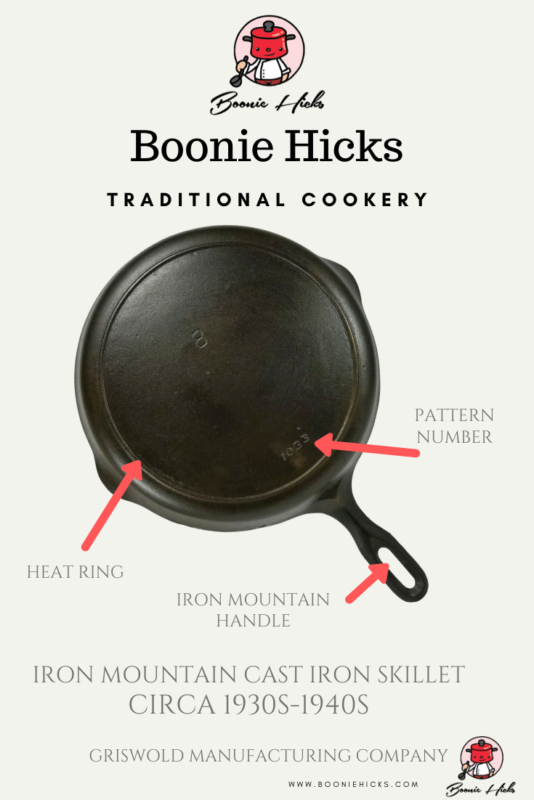
Griswold Manufacturing Made Skillets For Other Companies.
Sears contracted with Griswold Manufacturing Company to make cast iron cookware for their department stores. The Cast Iron Collector also has information on cast iron store brands. Griswold store bands that included.
Store brands manufactured in the Griswold foundry.
Best Made | Manufactured in the 1920s |
Puritan | From the 1920s to the 1930s, Griswold Puritan cast iron had a pattern number at 6 o’clock. If you have Puritan cast iron, click the link to learn more. |
Good Health | Made from the 1920s to 1930s |
Merit | Circa 1920s-1940s |
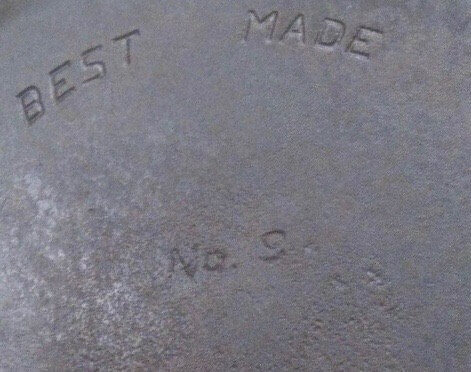
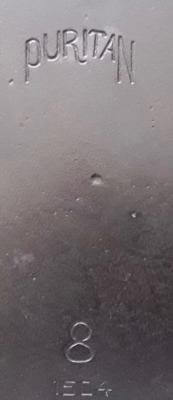
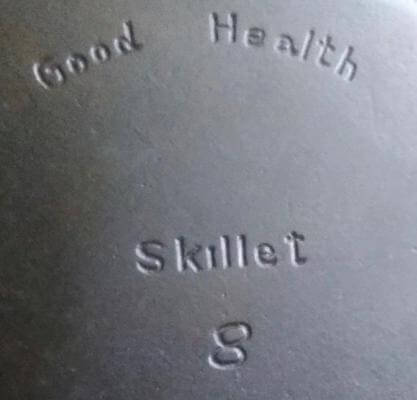
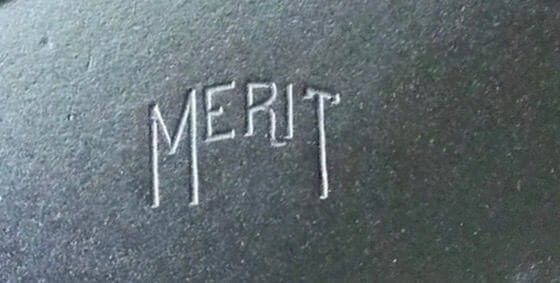
Griswold Skillets Are Great, But Take Your Time Buying One.
Suppose you have a Griswold Cast iron skillet. Then you should be one proud owner. Many pay a premium for Griswold cast iron skillets. However, the word is out Griswold to the name to collect. And some sellers are asking hefty prices. Just take your time if you want to buy one of these beauties.
Griswold Made Other Brands.
Do you have an Erie or a Griswold? Then you have yourself one fine skillet. But the store brands and the Iron Mountain range are good as well. Even though smooth bottom skillets are not as collectible, many prefer them on modern hobs.
There is good reason Griswold has the reputation of making some of the best antique cast-iron you can cook with.
Enjoy your skillet.
Helpful Articles For Further Reading On Griswold Cast Iron.
Once you have finished reading this article, I have written beginner’s guides to Griswold skillets. To help non-collectors use and enjoy their Griswold ironware.
- Where are the best places to buy Griswold ironware as a novice?
- How can I spot faults in the skillet and avoid overpaying?
- Is my antique skillet worth anything?
- Should I buy a Griswold cast iron skillet?
If You Have Enjoyed This Article, Check Out My Other Articles On Vintage Cast Iron.
- Wagner Wagner was Griswold Manufacturing’s main Competitor.
- Wapak Hollow Ware used Erie skillets for templates for their cast iron skillets.
- Favorite Stove And Range made excellent cast iron. Favorite Piqua Ware, in my opinion, is equal to Wagner and Griswold.
- Sidney Hollow Ware is one of my favorite makers. They also made their cast iron extremely light.

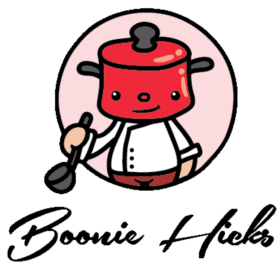
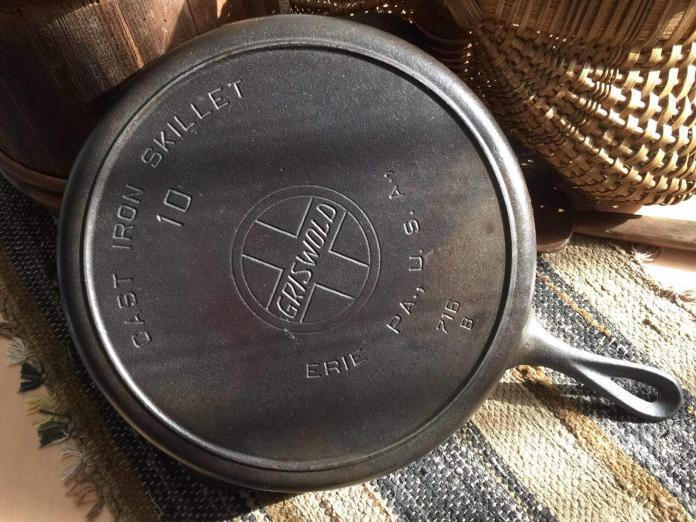
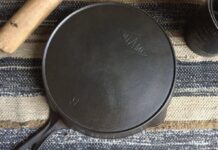
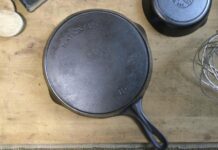
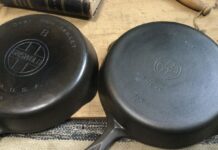



I just inherited a Griswold block logo number 9, but apart from the bottom of the pan, and half of the interior that are both black from cooking, my pan looks silver. I’ve never seen a silver cast iron before. Is this unusual?
Hi Daina
Thanks for getting in touch.
It sounds like the skillet has gone to a loving home.
It’s not unusual to see shiny or silvery skillets. Your skillet is probably plated in chrome or nickel. It often sounds scary to those new to vintage cast-iron. But nickel and chromium are both used today to produce stainless steel. Just like stainless steel chrome and nickel were used to prevent corrosion and the iron rusting.
Hope this helps and enjoy your number 9
Mine says GRISWOLD’S “ERIE” 701B and is a family heirloom. The cooking surface is fine but the exterior is heavily caked with carbonized stuff. I figure that’s probably not too healthy. How does one clean the exterior safely?
Hi Chuck
Thanks for getting in touch
You’re very lucky to have a Griswold’s “Erie” as an heirloom piece. I don’t see them come up for sale that often.
There’s several different methods on removing buildup. However, electrolysis is one of the preferred methods among collectors. But this takes time and potentially a little outlay. And it’s also a lot of work for one piece. The easy-off method and burning the seasoning off in the oven probably makes the most sense for a single pan.
But methods both are not without their drawbacks. The easy-off method requires you to spray your skillet with harsh chemicals and the other will temperately smoke out the house. Choose a fine day so you can have your windows wide open if you go with this option.
Type in “How to remove seasoning from cast iron” on YouTube. There are some very good videos you can use as tutorials. But whatever method you prefer, please avoid using power tools on your vintage ironware.
Good luck and have fun with your restoration project.
Loved your article and it sure did help to identify. The skillet I have looks to be one made in the 1940’s with the small block lettered logo and Erie under it. My question is you didn’t mention anything about the skillet being hammered. Mine is hammered. Are most of the skillets hammered and you just didn’t mention it and I’m just a dummy 😊?
Kate
Hello Kate
Thanks for your question and it a great one too.
Well done dating your skillet using the logo and I can confirm your skillet was probably made in the 1940s. Hammered Griswold ironware is very collectible and quite scarce. So you’re very lucky. On your skillet you’ll see a tab opposite the handle. This was designed for a hinged lid.
Cheers for your question, enjoy your Griswold
Hello — I was really happy to find your site! It has a lot of great information on it. I was wondering about two pans I got from my mom which I think may have been her mother’s. One is marked ERIE in big block letters with the number 9 with no other markings, the other is approximately 5″ across the base and the bottom says ERIE PA and has some sort of round logo in the center but it’s indecipherable (it’s well well used). I was wondering if you could tell me something about them. I love them very much — the small one always sat on our stove when I was growing up. My father cooked his eggs in them every morning! Thank you very much for any information you can give me about them.
Hi Michelle
Thanks for your contact and it’s always nice to hear from owners with heirloom pieces. And I’m sure your mother and grandmother are so happy you’re looking after their antique cookware.
You might have noticed from the article Erie cast iron was made by the Griswold Manufacturing Company. These pans can be separated into different series by the style of the handle, logo design and pattern number. It’s interesting your Erie has no other numbers or markings. It sounds like you could have a first or second series Erie skillet. If you do, you’re very lucky and your pan could be circa 1880-1892. I’m hoping to get around to adding information about Erie skillets when I finally get some free time.
Your other skillet is harder to identify without but it sounds like a Griswold skillet with a small logo. These skillets have different handles but for a date of manufacture you’re looking at circa 1939-1957.
Hope this helps, enjoy your vintage ironware.
Hi! have enjoyed the information. I have a Griswold with a heat ring, size 12. With a smaller logo-straight letters in the middle. ERIE PA under that, and 719.
I would assume the manufacturing date is 1939 to 1957 because of logo, but it also has a heat ring.
Hi Barbara
Thanks for your question
I’m really happy you have enjoyed the article. And it sounds like you have correctly identified your skillet. Because your skillet has a small logo with heat ring we can narrow the date of manufacture. I believe your skillet is around 1939-1944. So great spotting,
I hope this helps and enjoy your vintage Griswold.
Hi there,
I was wondering about identifying Dutch ovens. Would a slant logo Dutch oven with no heat ring date similarly to a skillet? Do same rules apply for aging? i.e., without heat ring circa 1929 and after?
There are no markings on outside of lid.
Thanks, you’ve obviously put a lot of work into this site and have some great info.
Sabra
Hi Sabra
Thanks for the question and kind words. I’m really pleased you have found the article useful.
You should be able to get a rough estimate on the age of your Griswold Dutch oven by looking at the logo. These old Dutch don’t have a heat ring but we can look at the logo and markings on the lid for a possible date of manufacture. Your lid doesn’t have raised lettering which is an indication of an earlier model. I suspect this slant logo without E.P.U. marking is circa 1906-1916.
Cheers, I hope this helps.
I’m so glad that I found this site. I easily discovered information about my new 6 inch small logo Griswold.( just a good cooker lol)
I have a question about seasoning, I have several of my grandmother’s skillets with heavy seasoning that has become very uneven. Does it affect value to lye strip and re-season these pans so that I feel comfortable using them? While I will never part with them I sure don’t want to devalue them either.
Thank you.
Hi Bryan
Thanks for the getting in touch.
I’m sure your grandmother would be so pleased you’re going to restore her old skillets.
Electrolysis and lye are two preferred methods with cast-iron enthusiasts to remove old seasoning. Lye should munch away at the old seasoning but leave the iron surface undamaged.
You might have seen restoration videos removing rust using vinegar, this is where you’ll need to keep an eye on the time to avoid pitting. You’ll also see videos using power tools, this will drastically reduce the value of your pans. Best to keep them in original condition.
Hope this helps and have fun with your restoration project.
I have a number 8 (12 o’clock position) Griswold slant within the cross/double circle with ERIE (no quotation marks) underneath 704 H. It also has a heat ring. Please let me know the approximate year of manufacture.
Hi Vince
Thanks for getting in touch.
There are several variations of the Griswold slant logo. But from your description it sounds like your skillet is circa 1906-1929. So, it’s an old-timer. And you’re very lucky, slant logos are highly sought-after by enthusiasts.
Hope this points you in the right direction and enjoy your vintage Griswold.
I have a Griswold, name is within a cross and double circle, underneath is Erie, PA, under that is 704 and under that is J, just wondering about the age, it’s by far my favorite skillet
Hi Denise
Thanks for your question.
You’re welcome to double check and compare your skillet with the examples in the article. However, it sounds like your Griswold has a smooth bottom and a small logo. These great pans were made circa 1939-1957. I’m really happy you’re enjoying your old skillet and being part of the cast iron community.
Cheers, happy cooking.
I just bought a #8 small logo nickle or chrome plated Griswold and cannot find any info on this. Do you have any info, thanks
Hi Kelli
Congratulations on your purchase I hope you’re getting a lot of use from your skillet.
From my understanding Griswold manufactured their regular cast iron and their plated skillets at the same time. So we can use the logo to get an idea when your skillet was made. Small Logo with a subtle heat ring around the edge your skillet was made circa 1939-1944. However, if your skillet has a smooth bottom and either a scooped or grooved handle then I’d place circa 1944-1957.
Cheers, hope this helps
Thank you for the effort into this article I was able to learn a lot about the series 3 #8 I recently picked up from and old friend. The question I have is concerning the hooked R on this pan and if there has been any insight as to why or how long it was used? Thank you again and have a great day
Regards
Jason
Hi Jason
Thanks for your question.
It sounds like your friend knows their stuff about vintage cast iron.
From my understanding series 3 Erie skillets were manufactured between Circa 1892-1905. During this time you’re likely to see a few slight variations. Including the letter R with a little flick at the end.
It’s really fun to speculate. Did they start to hook the R at the end of the series 3 production? Series 4 is known as the artistic Erie so maybe someone at Griswold wanted to be a little more creative and add a little flare.
Whatever the reason, it’s some pretty cool iron. You’re very lucky to have a piece of cast iron history.
Enjoy your skillet
What a great resource!
I have a pan that doesn’t seem to fit any of the descriptions though. I’m betting it’s one of the newer ones and I’m just curious. My Uncle bought it from an antique shop in New Mexico and it has sentimental value just because if that.
It has the cross in a circle Griswold logo in the middle, the. 11 1/4 INCH SKILLET under that and MADE IN USA under that.
No other markings and nothing above the Griswold logo at all. Like I said, I bet it’s one of the very last made, but it cooks like a dream and never leaves thr stove top!
Hi Royal
Thanks for your kind words and I’m really pleased you’ve found the resource useful.
I’d say your Griswold was made post 1957 so you’re right-on point with it being a later pan. The missing Erie P.A. marking is a telltale sign it wasn’t made in the Griswold foundry. Instead it was probably made in the Wagner foundry Circa 1957-1960s.
Hope this helps and it’s fantastic you’re proudly displaying and getting lots of use out of your family heirloom.
Thank you so much! It will always be my “everyday” skillet, but need to find some old ones now. 🙂
Thanks Boonie! I have a skillet similar to Royal’s, but slightly different, It’s a #9. Smooth bottom, small GRISWOLD logo, no slant, and beneath the logo it says “11 1/4 INCH SKILLET”. However, unlike Royal’s, it does not say “made in USA” underneath that, but far below it near the edge is a symbol that appears to be the german letter Eszett – it looks like a capital B, but somewhat like the lower case Greek letter beta. The same symbol is on the underside of the handle. Maybe it’s just an English capital B – letters in cast iron aren’t always the most precise.
Hi Todd
Thanks for adding to the conversation and giving a detailed description of your skillet. It really helps readers identify their skillets. And I think you’re spot on. You have a Griswold made with a Wagner mold.
Hello! Your website is a great resource, thanks so much! I looked over your description of each type of Griswold logo etc. to figure out the age of my Griswold Dutch Oven. It has number 9 on top, then beneath it the slanted Griswold logo in a cross and circle around it, then below “ERIE” (this includes the quotation marks) and finally beneath that 834 C.
The bottom of the Dutch Oven is smooth, no ring. The accompanying lid has the 9, the same slanted Griswold logo, beneath that ERIE (not in quotation marks), and then at the bottom 2552. I’m not interested in the value, as I want to keep it, but would love to know within what time range it was made.
Any thoughts? Thank you so much!
Hi John
Thank for the question. I’m really pleased you want to keep and use your Dutch Oven. You have an early oven too. Usually I see Griswold ovens with a block logo and EPU. The Slant logo without EPU was made earlier and I place it around 1906-1916. So it’s a real old-timer but I bet it cooks just as well as any modern oven.
Happy cooking
Hi there, some years ago my mother gave me a cast-iron skillet. I’ve been using it increasingly and at this point use it so often that it sits on my stove 24/7 because I don’t see the point in hauling it up from a cabinet.
I’ve taken off the seasoning and re-seasoned it the last couple of days and grew curious about its origins. In looking at your guide it seems to be an #8 Griswold slant logo with E.P.U and heat ring circa 1909-1929. I wondered if the additional markings “704M” with a small “dot” just under the “7” would help narrow the date rang at all???
When I asked my mother where it came from, she said she thought it had been her grandmother’s skillet. So, that makes sense with the time frame but didn’t help narrow it down at all. All in all, pretty cool to be the 4th generation cooking in this pan 🙂
Thanks for the great guide!
Hi Megan
Thanks for sharing and I’m so happy you’re enjoying your grandmothers skillet. Fourth generation owner is truly amazing but it also sounds like your skillet is in good hands.
I’m glad you could use the guide to date and identify your Griswold. Yes, I think you can use the mold letter to narrow the date of manufacture. As to how much I’m uncertain but it’s safe to assume it was made in the middle to the latter half of the manufacturing period. So your skillet could have been made in the Roaring Twenties. Very cool.
Hope this helps and enjoy using your family heirloom.
Boonie, I’ve located a Griswold, 8, #777, has cast iron skillet 8 , or chicken pan, Erie Pa U S A
Wondering mfg date and value?
Hi Doc
Thanks for getting in contact.
Griswold Manufacturing made the #777 chicken pan in both large and small logo.
From your description the pan sounds like it has the more desired large block logo with EPU. These pans in good condition are not cheap. Collectors will look for pans with a lid and if it sits flat. Because these fryers are often subject to high temperatures, many pans will rock or have movement. A Chicken Pan with Large block EPU logo was made circa 1930-1939.
Hope this helps
I have a large block letter smooth bottom 8″ # 726 skillet that was my mother in laws. It has a wooden handle. I can’t seem to find any information on it other than probably made between 1930-1939. Any info?
Hi Paul
Thanks for sending in a question.
I’m sure your mother-in-law is overjoyed that you are researching her skillet. You’re right, looking at the logo on the pan should give estimate of the age.
Despite the scarcity, Griswold manufactured skillets with a wooden handle for a long period of time. And they were manufactured between 1890s-1940. I agree with your estimation, it sounds like your skillet was made between 1930-1939.
Thanks for getting in touch and enjoy your vintage pan.
Cheers
Hi Boonie,
I have a Griswold 9, 710, large block with EPU. It’s well seasoned with a lot of build up on the outside. Not uncommon. What is, though, is the extremely high polished or plated appearance. At first glance it looks like high polished steel. I don’t see this type of finish in any of the pictures I’ve seen. Any thought’s?
Great site, learned a lot.
Hi Tom
Thanks for your question and I’m really happy you’ve enjoyed the site.
It not uncommon to see plated Griswold cast iron. And from your description it sounds like your skillet could be chrome plated.
Nickel has a softer and sometimes yellow appearance, while chrome is highly polished. The use of chrome also coincides with Griswold using the large block logo. Often on plated cast iron the chrome or nickel has worn off over the years of use and cleaning and it’s rare to find one with perfect plating.
I hope this helps and enjoy using your vintage ironware.
Hi Boonie
Great Website, I’ve been collecting for 50 yrs.
And have 2 many pans to count lol
Have an Erie Pan #8 with an arrow pointing at center of pan. It has a mirror surface and heavy suet on the bottom. I love these pans and have cooked over wood for years. True history of use. See an arrow Erie before?
Hi Michael
It’s great to hear from another collector like yourself, and I’m pleased you enjoy the site.
Hoping to grow the site slowly and move to old-time recipes. Needless to say, using some vintage ironware.
I’m very envious of your Erie pan. It sounds like a second series Erie.
You’re very lucky.
Hello Boonie
I have a Griswold Dutch Oven, it has a Griswold slanted and EPU logo underneath. Can you tell me the approximate date range? Also, there is no heat ring underneath. I guess vintage Dutch Ovens didn’t use heart rings. Any help you can provide is most appreciated. Thanks in advance.
Hello Bill
Thanks for your question.
The design change from the 18th century to 19th century pot design is quite interesting. However, 20th century Dutch Ovens are commonly footed or have a flat base.
A Griswold Dutch Oven is a very fine pot. I’d say your Dutch Oven was made in the 1920s. You’re very lucky.
Thanks again Bill, I hope this helps.
Hello Boonie
I live in England, have found myself an owner (or guardian) of a Griswold No8 Dutch oven for a mere £5 from a local 2nd hand shop. I’m amazed and wonder how a piece like this found its way over here. But you ship the likes of tanks etc here so why not an old pot. Found your website very interesting on researching this, it’s in very good condition needing a light restore and season. It has a large logo with Griswold in block capitals (not slanted) with ERIE PA. U.S.A , MAR 16. 20 below with tite-top above the logo. The lid now has me wondering if original as the only marking is 8 on top cover with a dimpled effect, with circular ribs on the underside it fits perfectly.
I have no idea why I checked this out only for age I guess, I would never imagined these are collectible, certainly not over here in the UK
Any info would be gratefully appreciated
Regards
Richard
Hi again
After endless searching I found only 2 photos of the lid, one on a Wagner and the other on a Griswold, It’s not the more common “ugly hammered finish” on the lid, the dimples are much larger.
Have a wonderful Christmas
Hello Richard
Thanks for your contact, I’m really happy you’ve found the site interesting and useful.
It sounds like you’ve found yourself a real bargain, but it also sounds like your Dutch Oven has gone to a great home in England.
Today, many of the high-end manufacturers such as Le Creuset and Staub like to promote a tight fitting lid as a premium product. And they often have a price tag to match. But Griswold advertised their Tite-Top brand a little differently. They advertised their Tite-Top Dutch Ovens as a great way for households to economize. Families could use lower priced cuts of meat and the tight fitting lid on their Dutch Ovens would make the meat soft and tender. Griswold manufactured these ovens over a long period of time. From your description, I’d suspect your oven was made between 1920-1950.
The lid on your oven has me guessing. On a Griswold Tite-Top oven I would like to see a matching lid. An unmarked lid with a raised number and circular ribs sounds like the Griswold Iron Mountain series I’m not sure if this series had a lid with a hammered finish. I’ve seen a few of these lids on unmarked chicken fryers fitting your description. Type in “unmarked hammered chicken fryer” into Google image search. I think you might find a lid similar to yours.
Hope this helps with your research. Have a great Christmas in old Blighty.
Best wishes
Brett a.k.a. Boonie
Ah thank you for replying, and the help with the information. Whilst I have been stroking it wondering how my beef stew with crispy dumplings are going to turn out, though my wife discovering it maybe worth upto twenty times what I paid for it she is stroking it thinking a new dress. I will have to guard it until she samples a few meals from it. I hope your finishing off your Boxing Day with some cheer, I certainly am with the help of a Cognac.
Once I have restored my Griswold I will send you a couple of photos via an email I see in another comment for your interest.
Until then seasons greetings & have a wonderful New Year
All the best
Richard
P.S. Here is a video to a favourite much recommended Beef Stew you must try
https://youtu.be/H4SYCyIZYpA
Greetings from Tucson, AZ Richard. Interesting as well to hear that they are not ‘collectible’. I can understand ‘why’ but they are; for sure. In any case, you DO have a very valuable piece. If you wanted to sell it online, I’m sure someone in Europe, possibly American would certainly purchase it for the right price. If I still lived in Europe, that person would be me!! LOL.
Hello Rob
Nice to hear. I’m not one told hold onto anything if valuable but I have wanted a Dutch oven for some time, once restored I may test interest on fleaBay and if I’m able to buy another cast iron Dutch oven and have cash left over whom am I to stop someone from enjoying a collectors item.
I’ve been to a few states in the US, living in Dallas for a few months and enjoyed them and the people greatly though Arizona is one I’d like to visit.
Have a great 2020
Richard
Boonie;
My wife was looking at her mothers Griswold skillets and ran across one that has the Block GRISWOLD cross and in a straight line under is cast “7 inch skillet”. idea on manufacture time period?
Hi Greg
Thanks for getting in touch.
I’d say your treasured Griswold skillet was made in the Wagner Sidney foundry when the company took over the rights of the Griswold patterns.
Check your skillet and you’re unlikely to see the markings “Erie P.A”, indicating it wasn’t made in the Erie foundry. Your wife’s skillet may have been made as early as 1958 but I’d say it’s more likely circa 1960s. Interestingly Wagner didn’t include “Made in the U.S.A.” on these skillets which was becoming standard practice around this time.
It’s a neat piece of cast iron history, Cheers, hope this points you in the right direction.